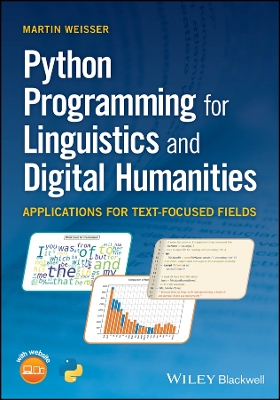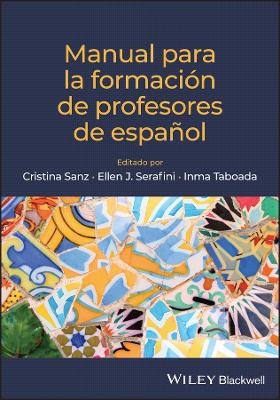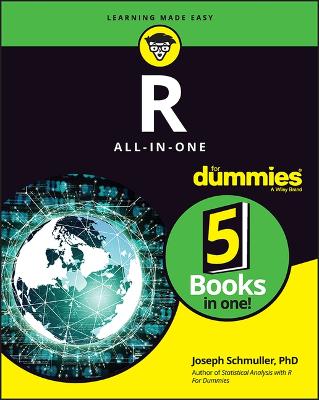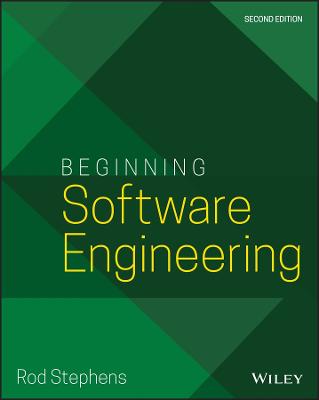Python Programming for Linguistics and Digital Humanities
 -15%
portes grátis
-15%
portes grátis
Python Programming for Linguistics and Digital Humanities
Applications for Text-Focused Fields
Weisser, Martin
John Wiley and Sons Ltd
02/2024
288
Mole
Inglês
9781119907947
15 a 20 dias
666
Descrição não disponível.
List of Figures xi
About the Companion Website xii
1 Introduction 1
1.1 Why Program? Why Python? 1
1.2 Course Overview and Aims 4
1.3 A Brief Note on the Exercises 5
1.4 Conventions Used in this Book 6
1.5 Installing Python 6
1.5.1 Installing on Windows 6
1.5.2 Installing on the Mac 7
1.5.3 Installing on Linux 8
1.6 Introduction to the Command Line/Console/Terminal 8
1.6.1 Activating the Command Line on Windows 9
1.6.2 Activating the Command Line on the Mac or Linux 9
1.7 Editors and IDEs 10
1.8 Installing and Setting Up WingIDE Personal 10
1.9 Discussions 11
2 Programming Basics I 15
2.1 Statements, Functions, and Variables 15
2.2 Data Types - Overview 17
2.3 Simple Data Types 18
2.3.1 Strings 18
2.3.2 Numbers 20
2.3.3 Binary Switches/Values 21
2.4 Operators - Overview 21
2.4.1 String Operators 21
2.4.2 Mathematical Operators 22
2.4.3 Logical Operators 24
2.5 Creating Scripts/Programs 25
2.6 Commenting Your Code 26
2.7 Discussions 28
3 Programming Basics II 33
3.1 Compound Data Types 33
3.2 Lists 35
3.3 Simple Interaction with Programs and Users 37
3.4 Problem Solving and Damage Control 38
3.4.1 Getting Help from Your IDE 38
3.4.2 Using the Debugger 39
3.5 Control Structures 40
3.5.1 Conditional Statements 41
3.5.2 Loops 42
3.5.3 while Loops 43
3.5.4 for Loops 44
3.5.5 Discussions 45
4 Intermediate String Processing 53
4.1 Understanding Strings 53
4.2 Cleaning Up Strings 54
4.3 Working with Sequences 55
4.3.1 Overview 55
4.3.2 Slice Syntax 56
4.4 More on Tuples 57
4.5 'Concatenating' Strings More Efficiently 59
4.6 Formatting Output 60
4.6.1 Using the % Operator 60
4.6.2 The format Method 61
4.6.3 f- Strings 61
4.6.4 Formatting Options 62
4.7 Handling Case 62
4.8 Discussions 63
5 Working with Stored Data 71
5.1 Understanding and Navigating File Systems 71
5.1.1 Showing Folder Contents 72
5.1.2 Navigating and Creating Folders 74
5.1.3 Relative Paths 75
5.2 Stored Data 76
5.3 Opening and Closing Files 76
5.3.1 File Opening Modes 77
5.3.2 File Access Options 77
5.4 Reading File Contents 78
5.5 Error Handling 79
5.6 Writing to Files 82
5.7 Working with Folders and Paths 83
5.7.1 The os Module 83
5.7.2 The Path Object of the libpath Module 84
5.8 Discussions 86
6 Recognising and Working with Language Patterns 93
6.1 The re Module 93
6.2 General Syntax 94
6.3 Understanding and Working with the Match Object 94
6.4 Character Classes 96
6.5 Quantification 97
6.6 Masking and Using Special Characters 98
6.7 Regex Error Handling 98
6.8 Anchors, Groups and Alternation 99
6.9 Constraining Results Further 101
6.10 Compilation Flags 101
6.11 Discussions 102
7 Developing Modular Programs 109
7.1 Modularity 109
7.2 Dictionaries 109
7.3 User- defined Functions 111
7.4 Understanding Modules 112
7.5 Documenting Your Module 115
7.6 Installing External Modules 116
7.7 Classes and Objects 117
7.7.1 Methods 118
7.7.2 Class Schema 118
7.8 Testing Modules 119
7.9 Discussions 120
8 Word Lists, Frequencies and Ordering 129
8.1 Introduction to Word and Frequency Lists 129
8.2 Generating Word Lists 129
8.3 Sorting Basics 130
8.4 Generating Basic Word Frequency Lists 131
8.5 Lambda Functions 132
8.6 Discussions 134
9 Interacting with Data and Users Through GUIs 143
9.1 Graphical User Interfaces 143
9.2 PyQt Basics 144
9.2.1 The General Approach to Designing GUI- based Programs 144
9.2.2 Useful PyQt Widgets 145
9.2.3 A Minimal PyQt Program 146
9.2.4 Deriving from a Main Window 148
9.2.5 Working with Layouts 148
9.2.6 Defining Widgets and Assigning Layouts 150
9.2.7 Widget Properties, Methods and Signals 150
9.2.8 Adding Interactive Functionality 152
9.3 Designing More Advanced GUIs 153
9.3.1 Actions 153
9.3.2 Creating Menus, Tool and Status Bars 153
9.3.3 Working with Files and Folder in PyQt 155
9.4 Discussions 159
10 Web Data and Annotations 171
10.1 Markup Languages 171
10.2 Brief Intro to HTML 172
10.3 Using the urllib.request Module 174
10.4 Extracting Text from Web Pages 177
10.5 List and Dictionary Comprehension 178
10.6 Brief Intro to XML 179
10.7 Complex Regex Replacements Using Functions 182
10.8 Brief Intro to the TEI Scheme 182
10.8.1 The Header 183
10.8.2 The Text Body 184
10.9 Discussions 188
11 Basic Visualisation 201
11.1 Using Matplotlib for Basic Visualisation 201
11.2 Creating Word Clouds 207
11.3 Filtering Frequency Data Through Stop- Words 208
11.4 Working with Relative Frequencies 210
11.5 Comparing Frequency Data Visually 212
11.6 Discussions 216
12 Conclusion 227
Appendix - Program Code 231
Index 273
About the Companion Website xii
1 Introduction 1
1.1 Why Program? Why Python? 1
1.2 Course Overview and Aims 4
1.3 A Brief Note on the Exercises 5
1.4 Conventions Used in this Book 6
1.5 Installing Python 6
1.5.1 Installing on Windows 6
1.5.2 Installing on the Mac 7
1.5.3 Installing on Linux 8
1.6 Introduction to the Command Line/Console/Terminal 8
1.6.1 Activating the Command Line on Windows 9
1.6.2 Activating the Command Line on the Mac or Linux 9
1.7 Editors and IDEs 10
1.8 Installing and Setting Up WingIDE Personal 10
1.9 Discussions 11
2 Programming Basics I 15
2.1 Statements, Functions, and Variables 15
2.2 Data Types - Overview 17
2.3 Simple Data Types 18
2.3.1 Strings 18
2.3.2 Numbers 20
2.3.3 Binary Switches/Values 21
2.4 Operators - Overview 21
2.4.1 String Operators 21
2.4.2 Mathematical Operators 22
2.4.3 Logical Operators 24
2.5 Creating Scripts/Programs 25
2.6 Commenting Your Code 26
2.7 Discussions 28
3 Programming Basics II 33
3.1 Compound Data Types 33
3.2 Lists 35
3.3 Simple Interaction with Programs and Users 37
3.4 Problem Solving and Damage Control 38
3.4.1 Getting Help from Your IDE 38
3.4.2 Using the Debugger 39
3.5 Control Structures 40
3.5.1 Conditional Statements 41
3.5.2 Loops 42
3.5.3 while Loops 43
3.5.4 for Loops 44
3.5.5 Discussions 45
4 Intermediate String Processing 53
4.1 Understanding Strings 53
4.2 Cleaning Up Strings 54
4.3 Working with Sequences 55
4.3.1 Overview 55
4.3.2 Slice Syntax 56
4.4 More on Tuples 57
4.5 'Concatenating' Strings More Efficiently 59
4.6 Formatting Output 60
4.6.1 Using the % Operator 60
4.6.2 The format Method 61
4.6.3 f- Strings 61
4.6.4 Formatting Options 62
4.7 Handling Case 62
4.8 Discussions 63
5 Working with Stored Data 71
5.1 Understanding and Navigating File Systems 71
5.1.1 Showing Folder Contents 72
5.1.2 Navigating and Creating Folders 74
5.1.3 Relative Paths 75
5.2 Stored Data 76
5.3 Opening and Closing Files 76
5.3.1 File Opening Modes 77
5.3.2 File Access Options 77
5.4 Reading File Contents 78
5.5 Error Handling 79
5.6 Writing to Files 82
5.7 Working with Folders and Paths 83
5.7.1 The os Module 83
5.7.2 The Path Object of the libpath Module 84
5.8 Discussions 86
6 Recognising and Working with Language Patterns 93
6.1 The re Module 93
6.2 General Syntax 94
6.3 Understanding and Working with the Match Object 94
6.4 Character Classes 96
6.5 Quantification 97
6.6 Masking and Using Special Characters 98
6.7 Regex Error Handling 98
6.8 Anchors, Groups and Alternation 99
6.9 Constraining Results Further 101
6.10 Compilation Flags 101
6.11 Discussions 102
7 Developing Modular Programs 109
7.1 Modularity 109
7.2 Dictionaries 109
7.3 User- defined Functions 111
7.4 Understanding Modules 112
7.5 Documenting Your Module 115
7.6 Installing External Modules 116
7.7 Classes and Objects 117
7.7.1 Methods 118
7.7.2 Class Schema 118
7.8 Testing Modules 119
7.9 Discussions 120
8 Word Lists, Frequencies and Ordering 129
8.1 Introduction to Word and Frequency Lists 129
8.2 Generating Word Lists 129
8.3 Sorting Basics 130
8.4 Generating Basic Word Frequency Lists 131
8.5 Lambda Functions 132
8.6 Discussions 134
9 Interacting with Data and Users Through GUIs 143
9.1 Graphical User Interfaces 143
9.2 PyQt Basics 144
9.2.1 The General Approach to Designing GUI- based Programs 144
9.2.2 Useful PyQt Widgets 145
9.2.3 A Minimal PyQt Program 146
9.2.4 Deriving from a Main Window 148
9.2.5 Working with Layouts 148
9.2.6 Defining Widgets and Assigning Layouts 150
9.2.7 Widget Properties, Methods and Signals 150
9.2.8 Adding Interactive Functionality 152
9.3 Designing More Advanced GUIs 153
9.3.1 Actions 153
9.3.2 Creating Menus, Tool and Status Bars 153
9.3.3 Working with Files and Folder in PyQt 155
9.4 Discussions 159
10 Web Data and Annotations 171
10.1 Markup Languages 171
10.2 Brief Intro to HTML 172
10.3 Using the urllib.request Module 174
10.4 Extracting Text from Web Pages 177
10.5 List and Dictionary Comprehension 178
10.6 Brief Intro to XML 179
10.7 Complex Regex Replacements Using Functions 182
10.8 Brief Intro to the TEI Scheme 182
10.8.1 The Header 183
10.8.2 The Text Body 184
10.9 Discussions 188
11 Basic Visualisation 201
11.1 Using Matplotlib for Basic Visualisation 201
11.2 Creating Word Clouds 207
11.3 Filtering Frequency Data Through Stop- Words 208
11.4 Working with Relative Frequencies 210
11.5 Comparing Frequency Data Visually 212
11.6 Discussions 216
12 Conclusion 227
Appendix - Program Code 231
Index 273
Este título pertence ao(s) assunto(s) indicados(s). Para ver outros títulos clique no assunto desejado.
Python programming; Python linguistics; Python digital humanities; Python social sciences; Python text processing; Python text analysis; Python computational linguistics; Python corpus linguistics; Python basics; Python intro; Python language analysis; Python data visualization
List of Figures xi
About the Companion Website xii
1 Introduction 1
1.1 Why Program? Why Python? 1
1.2 Course Overview and Aims 4
1.3 A Brief Note on the Exercises 5
1.4 Conventions Used in this Book 6
1.5 Installing Python 6
1.5.1 Installing on Windows 6
1.5.2 Installing on the Mac 7
1.5.3 Installing on Linux 8
1.6 Introduction to the Command Line/Console/Terminal 8
1.6.1 Activating the Command Line on Windows 9
1.6.2 Activating the Command Line on the Mac or Linux 9
1.7 Editors and IDEs 10
1.8 Installing and Setting Up WingIDE Personal 10
1.9 Discussions 11
2 Programming Basics I 15
2.1 Statements, Functions, and Variables 15
2.2 Data Types - Overview 17
2.3 Simple Data Types 18
2.3.1 Strings 18
2.3.2 Numbers 20
2.3.3 Binary Switches/Values 21
2.4 Operators - Overview 21
2.4.1 String Operators 21
2.4.2 Mathematical Operators 22
2.4.3 Logical Operators 24
2.5 Creating Scripts/Programs 25
2.6 Commenting Your Code 26
2.7 Discussions 28
3 Programming Basics II 33
3.1 Compound Data Types 33
3.2 Lists 35
3.3 Simple Interaction with Programs and Users 37
3.4 Problem Solving and Damage Control 38
3.4.1 Getting Help from Your IDE 38
3.4.2 Using the Debugger 39
3.5 Control Structures 40
3.5.1 Conditional Statements 41
3.5.2 Loops 42
3.5.3 while Loops 43
3.5.4 for Loops 44
3.5.5 Discussions 45
4 Intermediate String Processing 53
4.1 Understanding Strings 53
4.2 Cleaning Up Strings 54
4.3 Working with Sequences 55
4.3.1 Overview 55
4.3.2 Slice Syntax 56
4.4 More on Tuples 57
4.5 'Concatenating' Strings More Efficiently 59
4.6 Formatting Output 60
4.6.1 Using the % Operator 60
4.6.2 The format Method 61
4.6.3 f- Strings 61
4.6.4 Formatting Options 62
4.7 Handling Case 62
4.8 Discussions 63
5 Working with Stored Data 71
5.1 Understanding and Navigating File Systems 71
5.1.1 Showing Folder Contents 72
5.1.2 Navigating and Creating Folders 74
5.1.3 Relative Paths 75
5.2 Stored Data 76
5.3 Opening and Closing Files 76
5.3.1 File Opening Modes 77
5.3.2 File Access Options 77
5.4 Reading File Contents 78
5.5 Error Handling 79
5.6 Writing to Files 82
5.7 Working with Folders and Paths 83
5.7.1 The os Module 83
5.7.2 The Path Object of the libpath Module 84
5.8 Discussions 86
6 Recognising and Working with Language Patterns 93
6.1 The re Module 93
6.2 General Syntax 94
6.3 Understanding and Working with the Match Object 94
6.4 Character Classes 96
6.5 Quantification 97
6.6 Masking and Using Special Characters 98
6.7 Regex Error Handling 98
6.8 Anchors, Groups and Alternation 99
6.9 Constraining Results Further 101
6.10 Compilation Flags 101
6.11 Discussions 102
7 Developing Modular Programs 109
7.1 Modularity 109
7.2 Dictionaries 109
7.3 User- defined Functions 111
7.4 Understanding Modules 112
7.5 Documenting Your Module 115
7.6 Installing External Modules 116
7.7 Classes and Objects 117
7.7.1 Methods 118
7.7.2 Class Schema 118
7.8 Testing Modules 119
7.9 Discussions 120
8 Word Lists, Frequencies and Ordering 129
8.1 Introduction to Word and Frequency Lists 129
8.2 Generating Word Lists 129
8.3 Sorting Basics 130
8.4 Generating Basic Word Frequency Lists 131
8.5 Lambda Functions 132
8.6 Discussions 134
9 Interacting with Data and Users Through GUIs 143
9.1 Graphical User Interfaces 143
9.2 PyQt Basics 144
9.2.1 The General Approach to Designing GUI- based Programs 144
9.2.2 Useful PyQt Widgets 145
9.2.3 A Minimal PyQt Program 146
9.2.4 Deriving from a Main Window 148
9.2.5 Working with Layouts 148
9.2.6 Defining Widgets and Assigning Layouts 150
9.2.7 Widget Properties, Methods and Signals 150
9.2.8 Adding Interactive Functionality 152
9.3 Designing More Advanced GUIs 153
9.3.1 Actions 153
9.3.2 Creating Menus, Tool and Status Bars 153
9.3.3 Working with Files and Folder in PyQt 155
9.4 Discussions 159
10 Web Data and Annotations 171
10.1 Markup Languages 171
10.2 Brief Intro to HTML 172
10.3 Using the urllib.request Module 174
10.4 Extracting Text from Web Pages 177
10.5 List and Dictionary Comprehension 178
10.6 Brief Intro to XML 179
10.7 Complex Regex Replacements Using Functions 182
10.8 Brief Intro to the TEI Scheme 182
10.8.1 The Header 183
10.8.2 The Text Body 184
10.9 Discussions 188
11 Basic Visualisation 201
11.1 Using Matplotlib for Basic Visualisation 201
11.2 Creating Word Clouds 207
11.3 Filtering Frequency Data Through Stop- Words 208
11.4 Working with Relative Frequencies 210
11.5 Comparing Frequency Data Visually 212
11.6 Discussions 216
12 Conclusion 227
Appendix - Program Code 231
Index 273
About the Companion Website xii
1 Introduction 1
1.1 Why Program? Why Python? 1
1.2 Course Overview and Aims 4
1.3 A Brief Note on the Exercises 5
1.4 Conventions Used in this Book 6
1.5 Installing Python 6
1.5.1 Installing on Windows 6
1.5.2 Installing on the Mac 7
1.5.3 Installing on Linux 8
1.6 Introduction to the Command Line/Console/Terminal 8
1.6.1 Activating the Command Line on Windows 9
1.6.2 Activating the Command Line on the Mac or Linux 9
1.7 Editors and IDEs 10
1.8 Installing and Setting Up WingIDE Personal 10
1.9 Discussions 11
2 Programming Basics I 15
2.1 Statements, Functions, and Variables 15
2.2 Data Types - Overview 17
2.3 Simple Data Types 18
2.3.1 Strings 18
2.3.2 Numbers 20
2.3.3 Binary Switches/Values 21
2.4 Operators - Overview 21
2.4.1 String Operators 21
2.4.2 Mathematical Operators 22
2.4.3 Logical Operators 24
2.5 Creating Scripts/Programs 25
2.6 Commenting Your Code 26
2.7 Discussions 28
3 Programming Basics II 33
3.1 Compound Data Types 33
3.2 Lists 35
3.3 Simple Interaction with Programs and Users 37
3.4 Problem Solving and Damage Control 38
3.4.1 Getting Help from Your IDE 38
3.4.2 Using the Debugger 39
3.5 Control Structures 40
3.5.1 Conditional Statements 41
3.5.2 Loops 42
3.5.3 while Loops 43
3.5.4 for Loops 44
3.5.5 Discussions 45
4 Intermediate String Processing 53
4.1 Understanding Strings 53
4.2 Cleaning Up Strings 54
4.3 Working with Sequences 55
4.3.1 Overview 55
4.3.2 Slice Syntax 56
4.4 More on Tuples 57
4.5 'Concatenating' Strings More Efficiently 59
4.6 Formatting Output 60
4.6.1 Using the % Operator 60
4.6.2 The format Method 61
4.6.3 f- Strings 61
4.6.4 Formatting Options 62
4.7 Handling Case 62
4.8 Discussions 63
5 Working with Stored Data 71
5.1 Understanding and Navigating File Systems 71
5.1.1 Showing Folder Contents 72
5.1.2 Navigating and Creating Folders 74
5.1.3 Relative Paths 75
5.2 Stored Data 76
5.3 Opening and Closing Files 76
5.3.1 File Opening Modes 77
5.3.2 File Access Options 77
5.4 Reading File Contents 78
5.5 Error Handling 79
5.6 Writing to Files 82
5.7 Working with Folders and Paths 83
5.7.1 The os Module 83
5.7.2 The Path Object of the libpath Module 84
5.8 Discussions 86
6 Recognising and Working with Language Patterns 93
6.1 The re Module 93
6.2 General Syntax 94
6.3 Understanding and Working with the Match Object 94
6.4 Character Classes 96
6.5 Quantification 97
6.6 Masking and Using Special Characters 98
6.7 Regex Error Handling 98
6.8 Anchors, Groups and Alternation 99
6.9 Constraining Results Further 101
6.10 Compilation Flags 101
6.11 Discussions 102
7 Developing Modular Programs 109
7.1 Modularity 109
7.2 Dictionaries 109
7.3 User- defined Functions 111
7.4 Understanding Modules 112
7.5 Documenting Your Module 115
7.6 Installing External Modules 116
7.7 Classes and Objects 117
7.7.1 Methods 118
7.7.2 Class Schema 118
7.8 Testing Modules 119
7.9 Discussions 120
8 Word Lists, Frequencies and Ordering 129
8.1 Introduction to Word and Frequency Lists 129
8.2 Generating Word Lists 129
8.3 Sorting Basics 130
8.4 Generating Basic Word Frequency Lists 131
8.5 Lambda Functions 132
8.6 Discussions 134
9 Interacting with Data and Users Through GUIs 143
9.1 Graphical User Interfaces 143
9.2 PyQt Basics 144
9.2.1 The General Approach to Designing GUI- based Programs 144
9.2.2 Useful PyQt Widgets 145
9.2.3 A Minimal PyQt Program 146
9.2.4 Deriving from a Main Window 148
9.2.5 Working with Layouts 148
9.2.6 Defining Widgets and Assigning Layouts 150
9.2.7 Widget Properties, Methods and Signals 150
9.2.8 Adding Interactive Functionality 152
9.3 Designing More Advanced GUIs 153
9.3.1 Actions 153
9.3.2 Creating Menus, Tool and Status Bars 153
9.3.3 Working with Files and Folder in PyQt 155
9.4 Discussions 159
10 Web Data and Annotations 171
10.1 Markup Languages 171
10.2 Brief Intro to HTML 172
10.3 Using the urllib.request Module 174
10.4 Extracting Text from Web Pages 177
10.5 List and Dictionary Comprehension 178
10.6 Brief Intro to XML 179
10.7 Complex Regex Replacements Using Functions 182
10.8 Brief Intro to the TEI Scheme 182
10.8.1 The Header 183
10.8.2 The Text Body 184
10.9 Discussions 188
11 Basic Visualisation 201
11.1 Using Matplotlib for Basic Visualisation 201
11.2 Creating Word Clouds 207
11.3 Filtering Frequency Data Through Stop- Words 208
11.4 Working with Relative Frequencies 210
11.5 Comparing Frequency Data Visually 212
11.6 Discussions 216
12 Conclusion 227
Appendix - Program Code 231
Index 273
Este título pertence ao(s) assunto(s) indicados(s). Para ver outros títulos clique no assunto desejado.







